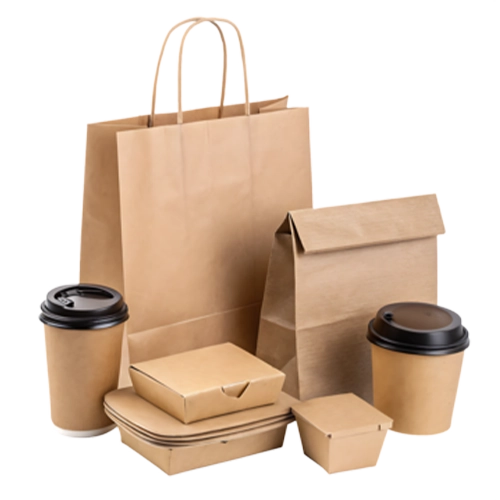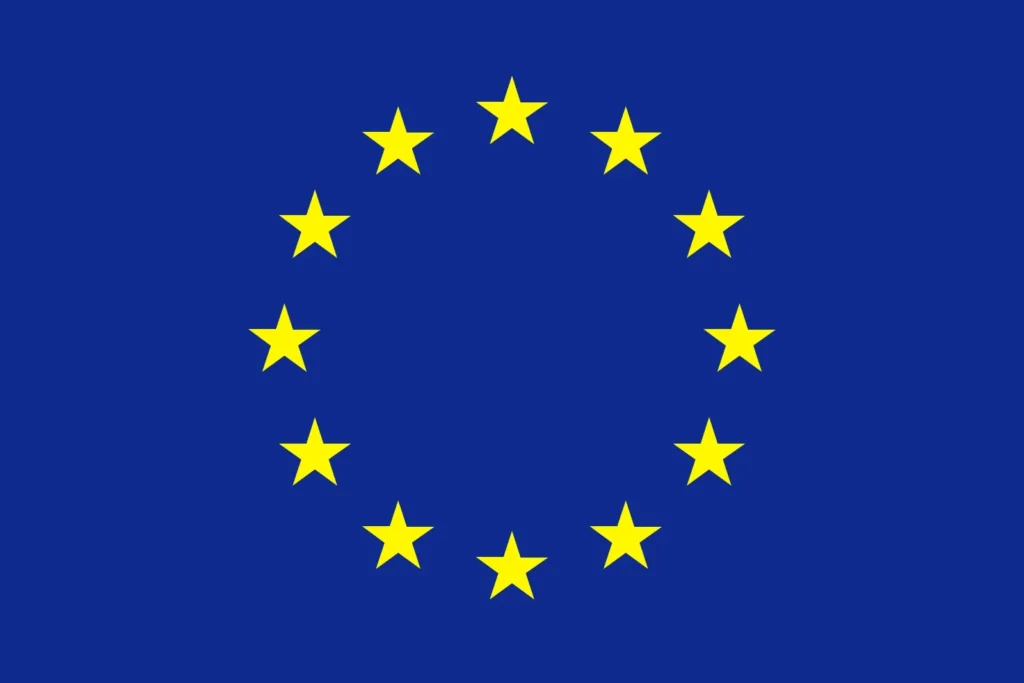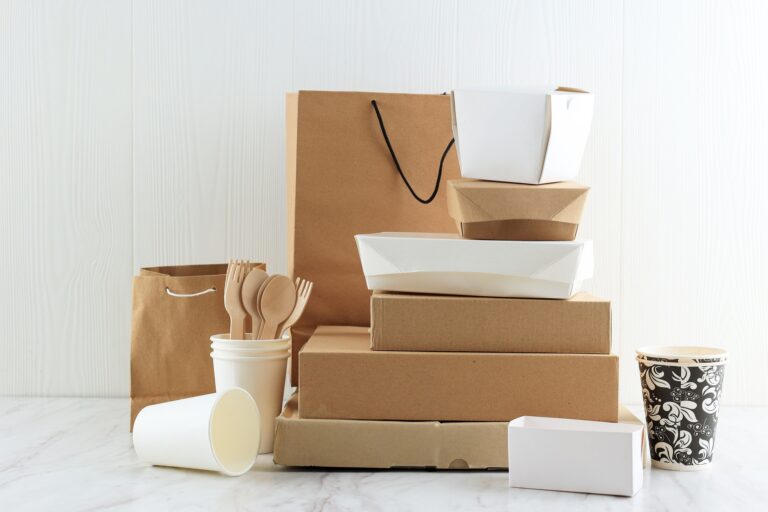Over 500 billion disposable cups are used worldwide each year, yet only a small fraction are properly recycled or composted. As regulations tighten and eco-conscious consumers drive change, businesses must carefully evaluate their packaging materials. For food service operators, retailers, and packaging distributors, the choice between paper cups vs plastic cups directly affects cost structure, environmental compliance, and customer experience.
In this article, we explore the key differences between paper cups and plastic cups in terms of cost, convenience, and environmental impact to help you make a more informed and sustainable decision.
What Are Your Cups Made Of?
Understanding the material composition of disposable cups is essential for making informed packaging decisions. Whether you prioritize cost-efficiency, heat resistance, or eco-friendliness, the materials used in paper cups and plastic cups will directly influence product performance and environmental compliance.
Disposable Paper Cups
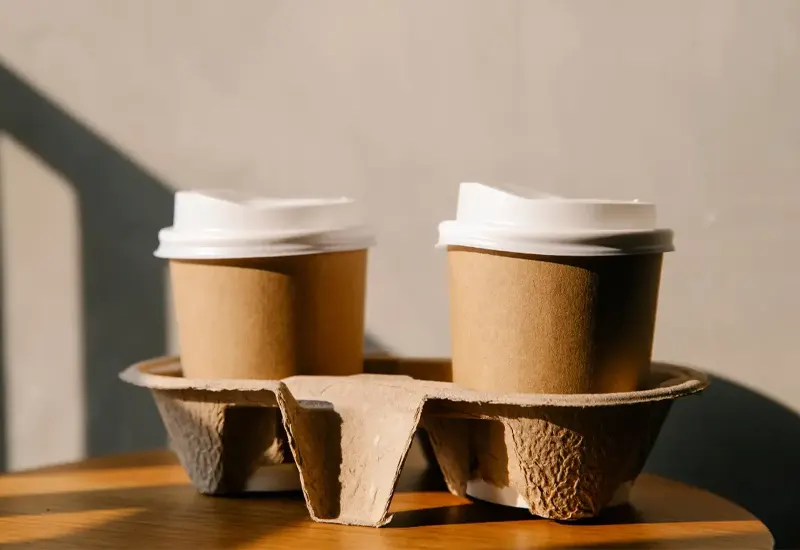
Disposable paper cups are primarily made from food-grade paperboard lined with a thin plastic or biopolymer coating to make them liquid-resistant. While paper is often viewed as a more sustainable material, the actual recyclability or compostability of paper cups depends heavily on the type of lining used and local waste infrastructure.
Types of Paper Cups:
- Single Wall Paper Cups
These are made from a single layer of paperboard with a thin plastic or PLA lining. They are lightweight and cost-effective, typically used for cold beverages or short-duration use. - Double Wall Paper Cups
Featuring two layers of paper with an insulating air pocket, double wall cups are ideal for hot drinks. They offer better heat protection and a more premium feel. - PLA-Lined Paper Cups
Lined with polylactic acid (a bioplastic derived from plants), these cups are marketed as compostable. However, they require industrial composting facilities to degrade properly. - PE-Lined Paper Cups
The most common type, lined with polyethylene plastic. They are moisture-resistant but not easily recyclable due to the fused plastic-paper structure.
Disposable Plastic Cups
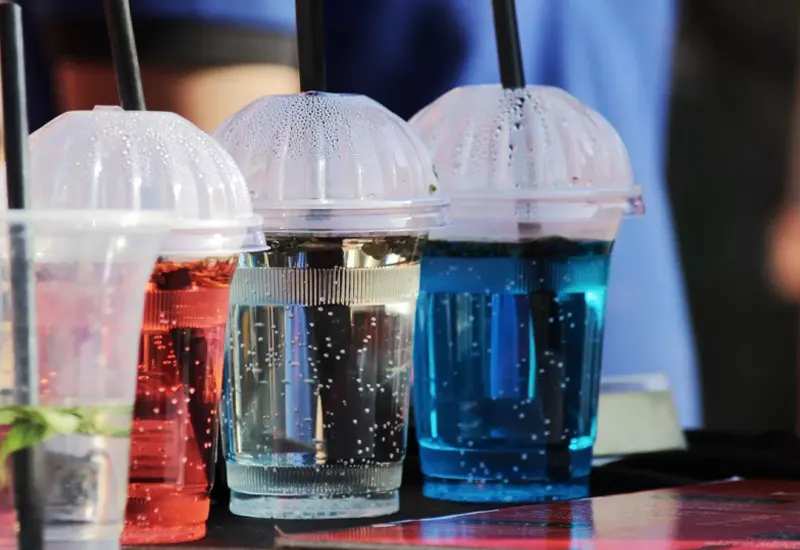
Plastic cups are widely used for cold drinks and are typically made from fossil fuel-based resins. They offer clarity, durability, and excellent price-performance ratio, but their environmental impact and end-of-life options vary significantly by type of plastic.
Types of Plastic Cups:
- PET (Polyethylene Terephthalate)
Clear, lightweight, and fully recyclable in many regions. Commonly used for iced coffee, smoothies, and soft drinks. - PP (Polypropylene)
Known for its flexibility and heat resistance, PP cups are less clear than PET but more suitable for hot-fill applications and microwave use. - PS (Polystyrene)
Lightweight and inexpensive, but rarely recyclable and increasingly banned due to environmental concerns. Often used for water or beer cups at events. - PLA (Polylactic Acid) Plastic Cups
A bio-based alternative to traditional plastic, these cups look similar to PET but are compostable under industrial conditions. Their recyclability is limited, and they require separate waste streams.
Differences Between Paper Cups vs Plastic Cups
When comparing paper cups vs plastic cups, businesses must look beyond surface-level differences. Each option has unique cost implications, health and safety considerations, functional benefits, and environmental impacts. Understanding these factors is critical for food service operators, retailers, and distributors aiming to balance affordability, performance, and sustainability. The following sections break down the most important aspects to guide your decision-making.
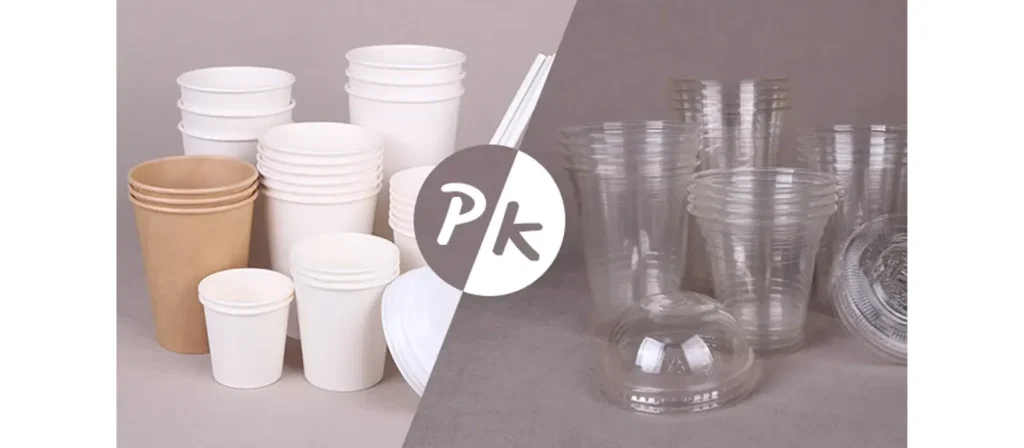
Cost Comparison
- Paper Cups
Paper cups are often more expensive to produce due to the cost of paperboard and the additional lining required to prevent leaks. Double wall or specialty-coated paper cups can further increase expenses. However, some businesses consider the higher price a worthwhile investment to meet consumer demand for eco-friendly alternatives. - Plastic Cups
Plastic cups are generally cheaper to manufacture at scale, especially when made from PET or PP. Their lower unit price makes them attractive for businesses serving large volumes of cold beverages. However, rising oil prices and regulatory restrictions on single-use plastics may increase long-term costs for companies relying heavily on plastic cups.
Health and Safety Considerations
- Paper Cups
Paper cups are considered safe for both hot and cold beverages, provided they are lined with food-grade materials. However, PE linings can release microplastics if improperly disposed of, and compostable PLA-lined cups require correct facilities to ensure safety and compliance. - Plastic Cups
Plastic cups are safe for cold beverages but may pose risks when used for hot drinks, depending on the material. PET cups are widely used and food-safe but unsuitable for high temperatures. PP offers better heat resistance but has less clarity. Some plastics, such as polystyrene, are facing increasing scrutiny due to potential health concerns and limited recyclability.
Convenience and Functionality
- Paper Cups
Paper cups provide good insulation, especially double wall versions, making them ideal for hot beverages like coffee and tea. They are easy to print on, offering strong branding opportunities. However, they are less suitable for drinks requiring transparency, such as iced teas or smoothies. - Plastic Cups
Plastic cups excel in cold beverage applications thanks to their durability and clarity. They showcase the product visually, which is an advantage for smoothies, iced coffees, and specialty drinks. They are stackable, lightweight, and resistant to moisture. On the downside, they do not insulate heat effectively, limiting their use for hot drinks.
Environmental Impact
Environmental impact is often the deciding factor in the debate between paper cups vs plastic cups. Both materials carry environmental burdens, but their impacts differ across production, usage, and disposal stages.
| Aspect | Paper Cups | Plastic Cups |
|---|---|---|
| Resource Use | Made from renewable paperboard but require additional coatings, consuming both forest and chemical resources. | Made from petroleum-based materials, heavily dependent on fossil fuels. |
| Waste Generation | Difficult to recycle due to plastic lining, often ending up in landfills. | Widely used but low recycling rates, with large volumes contributing to pollution. |
| Carbon Footprint | Higher during manufacturing because paper production is energy-intensive. | Lower production footprint but long-term environmental persistence increases impact. |
| Biodegradability | Partially biodegradable if free from PE lining, but most require composting facilities. | Non-biodegradable, remaining intact for centuries without proper recycling. |
| Decomposition Rates | Can decompose in months under correct composting conditions. | Can take hundreds of years to break down, releasing microplastics during the process. |
| Energy Consumption | High energy use in pulping and coating processes. | Energy-efficient in mass production but relies on non-renewable energy sources. |
While paper cups are often marketed as eco-friendly, their linings and production processes still carry significant environmental costs. Plastic cups consume fewer resources during production but pose greater long-term risks due to persistence and recycling challenges. Businesses should weigh these impacts alongside regulatory requirements and brand values when choosing between the two.
Applicable Scenarios and Beverages
- Paper Cups
Best suited for hot beverages such as coffee, tea, and hot chocolate. They are also appropriate for businesses emphasizing sustainable branding, as customers often perceive paper as a greener option. Paper cups work well in sit-down cafés, takeaway coffee shops, and events where insulation is important. - Plastic Cups
Most effective for cold beverages like iced coffee, smoothies, milkshakes, and soft drinks. Their transparency enhances product presentation, which is a key selling point for specialty drinks. Plastic cups are widely used in quick-service restaurants, fast-food chains, and outdoor events where durability and cost-efficiency are prioritized.
How to Choose the Right Cup for Your Needs?
Selecting the right type of cup requires looking at multiple factors that influence both business operations and customer experience. From cost and compliance to convenience and sustainability, each dimension shapes how paper cups and plastic cups perform in real-world scenarios. The following considerations provide a structured way to evaluate which option aligns best with your needs.
1. Cost Considerations
- Paper Cups
Paper cups generally cost more to manufacture due to paperboard material and liquid-resistant linings. Specialty designs such as double wall or compostable cups add further expense. Businesses operating in competitive markets may see these costs reflected in slimmer margins. - Plastic Cups
Plastic cups are usually cheaper to produce at scale, especially PET and PP types. Their lower unit price benefits businesses serving large volumes of cold drinks. However, increasing plastic taxes and bans could drive up costs in the future.
Total cost of ownership (TCO) checklist
Calculate cost per served drink rather than unit price alone:
- Cup + matching lid + sleeve (if needed) + straw or stirrer
- Shipping cost
- Storage footprint cost (space is money)
- Loss and damage rate (cracks, leaks, double-cupping)
- End-of-life cost (waste hauling, composting fees, recycling rebates if any)
Tip: double-wall paper can be cheaper overall than single-wall plus sleeve once you include sleeves, handling time, and customer comfort.
2. Branding and Customer Perception
- Paper Cups
Paper cups often enhance eco-friendly branding, appealing to consumers who value sustainability. They are easy to customize with logos and designs, making them a strong marketing tool for cafés and coffee shops. - Plastic Cups
Plastic cups provide excellent visibility for beverages, boosting presentation for colorful or layered drinks. This can strengthen product appeal but may conflict with customers’ growing preference for sustainable packaging.
3. Compliance and Regulations
- Paper Cups
Paper cups generally face fewer regulatory barriers, though recycling challenges exist. Compostable or certified options may help businesses meet sustainability standards and avoid future restrictions. - Plastic Cups
Plastic cups are subject to tightening regulations, particularly single-use plastics like polystyrene. Businesses must carefully monitor local and regional policies to ensure compliance and avoid penalties.
4. Convenience
- Paper Cups
Paper cups are lightweight and effective for hot drinks, providing insulation and comfort for customers. They are less durable for cold beverages with ice and may weaken over extended use. - Plastic Cups
Plastic cups are highly convenient for cold drinks, offering durability, clarity, and resistance to leaks. Their stackable design and sturdiness make them practical for busy, high-volume operations.
5. Drinking Experience
- Paper Cups
Paper cups provide a comfortable grip and insulation for hot beverages, ensuring safety and usability. They do not showcase beverages visually, which may reduce appeal for drinks with distinctive colors or textures. - Plastic Cups
Plastic cups enhance enjoyment of cold beverages by showcasing the product clearly and resisting condensation. However, they lack insulation for hot drinks, which can lead to discomfort if misused.

6. Sustainability Awareness
- Paper Cups
Consumers often view paper cups as more sustainable, boosting customer satisfaction and brand image. Still, recycling challenges and the need for industrial composting facilities mean the eco-friendly reputation does not always match reality. - Plastic Cups
Plastic cups face negative perceptions due to their long-lasting environmental impact and low recycling rates. Even when recyclable, many end up in landfills, which can harm a brand’s reputation with eco-conscious consumers.
7. Scenario Guide (what to pick and why)
| Scenario | Recommended cup | Why |
|---|---|---|
| Hot coffee or tea (everyday café) | Double-wall paper hot cups | Comfortable to hold, good heat retention |
| Extra-hot or premium takeaway | Ripple/insulated paper hot cups | Best hand comfort and brand feel |
| Iced coffee, milk tea, smoothies | Plastic PET or PP cold cups | Strength, clarity for mix-ins, straw-friendly |
| Carbonated soft drinks | Plastic PET cups | Handles fizz and condensation |
| Fresh juices/lemonade (non-carbonated) | Paper cold cups or plastic | Paper reduces plastic use; plastic offers clarity |
| Alcoholic beverages at events | Plastic PET or PP cups | Crack resistance and safety |
| Kids’ parties, outdoor festivals | Plastic PP cups | Durable, low break risk |
| Sustainability-focused venue with composting | Certified compostable paper cups or PLA plastic | Aligns with waste stream |
| Office pantry or water stations | Paper cold cups | Easy stocking, minimal footprint |
FAQs
- Are paper cups better for the environment than plastic cups?
It’s hard to say which is better, as both have trade-offs. Paper cups are easier for waste management since they break down faster, while plastic cups generally have a lower carbon footprint during production. The more sustainable option often depends on local recycling and waste facilities. - Are plastic cups safe for hot drinks?
Most plastic cups, such as PET, are not suitable for hot beverages as they can warp or release chemicals at high temperatures. PP (polypropylene) cups offer better heat resistance but are still less effective than paper cups for hot drinks. Businesses typically reserve plastic cups for cold beverages. - Which is cheaper: paper cups vs plastic cups?
Plastic cups are typically less expensive to manufacture and purchase, especially at scale. Paper cups usually cost more because of the paperboard and protective lining. However, businesses may accept higher costs to appeal to eco-conscious customers and comply with sustainability initiatives. - Which type of cup is better for branding and presentation?
Paper cups are easy to customize with logos and designs, making them ideal for businesses emphasizing brand identity. Plastic cups, on the other hand, highlight the drink itself with clarity, which is particularly effective for smoothies, iced coffees, and colorful beverages. - How long does it take for plastic cups to decompose?
Plastic cups can take hundreds of years to decompose, depending on the material and conditions. During this time, they may break down into harmful microplastics. Without proper recycling, most plastic cups remain in landfills or the natural environment for centuries.
Conclusion
The choice between paper cups vs plastic cups is not as simple as it may seem. Each option comes with its own strengths and limitations. Paper cups excel in hot beverage service, branding opportunities, and perceived sustainability, but they often come with higher costs and limited recyclability. Plastic cups provide durability, cost-efficiency, and strong product visibility, particularly for cold drinks, yet they face growing regulatory challenges and negative consumer perceptions related to environmental impact.
For businesses, the decision should balance cost structure, compliance, and customer expectations. For consumers, the focus often lies on convenience, drinking experience, and sustainability awareness. There is no single right answer, but aligning your choice with both operational needs and brand values will ensure long-term success.


